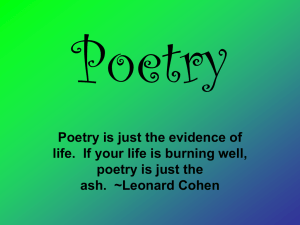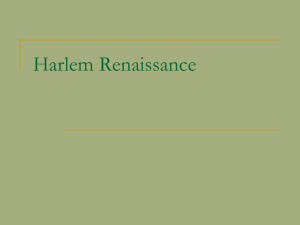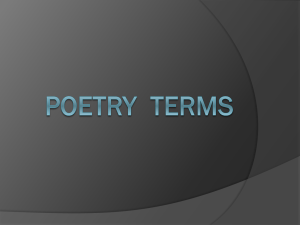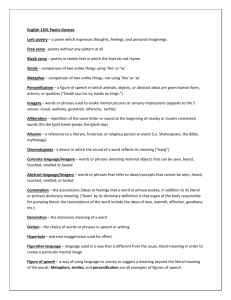terms for poetry and drama
advertisement
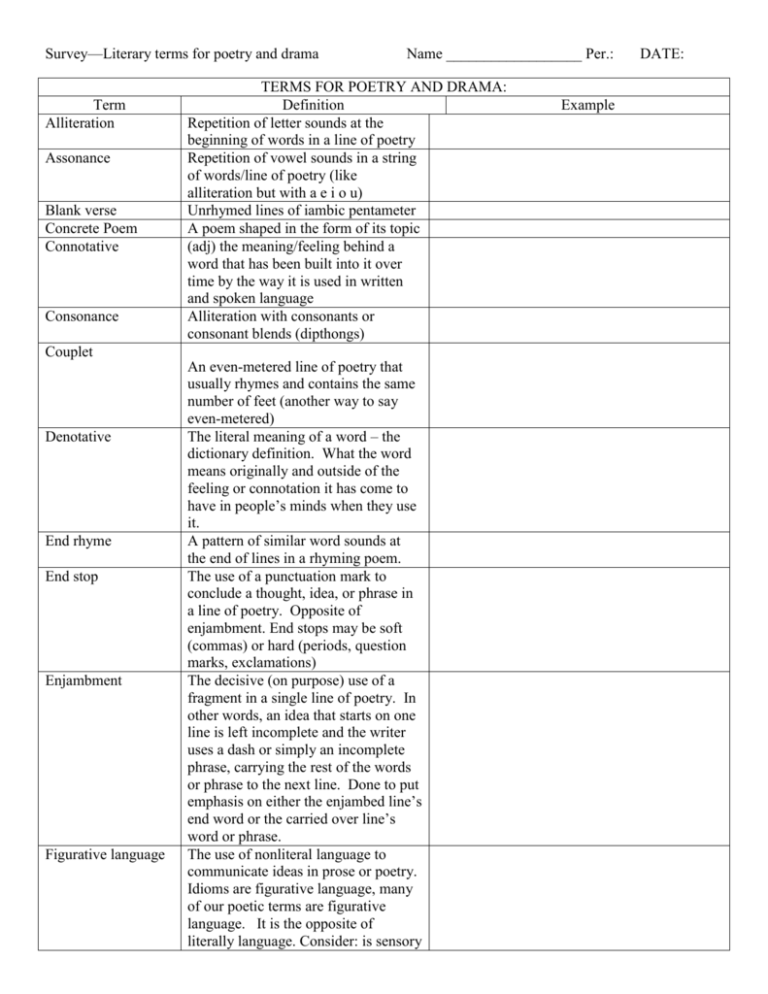
Survey—Literary terms for poetry and drama Term Alliteration Assonance Blank verse Concrete Poem Connotative Consonance Name __________________ Per.: TERMS FOR POETRY AND DRAMA: Definition Repetition of letter sounds at the beginning of words in a line of poetry Repetition of vowel sounds in a string of words/line of poetry (like alliteration but with a e i o u) Unrhymed lines of iambic pentameter A poem shaped in the form of its topic (adj) the meaning/feeling behind a word that has been built into it over time by the way it is used in written and spoken language Alliteration with consonants or consonant blends (dipthongs) Couplet Denotative End rhyme End stop Enjambment Figurative language An even-metered line of poetry that usually rhymes and contains the same number of feet (another way to say even-metered) The literal meaning of a word – the dictionary definition. What the word means originally and outside of the feeling or connotation it has come to have in people’s minds when they use it. A pattern of similar word sounds at the end of lines in a rhyming poem. The use of a punctuation mark to conclude a thought, idea, or phrase in a line of poetry. Opposite of enjambment. End stops may be soft (commas) or hard (periods, question marks, exclamations) The decisive (on purpose) use of a fragment in a single line of poetry. In other words, an idea that starts on one line is left incomplete and the writer uses a dash or simply an incomplete phrase, carrying the rest of the words or phrase to the next line. Done to put emphasis on either the enjambed line’s end word or the carried over line’s word or phrase. The use of nonliteral language to communicate ideas in prose or poetry. Idioms are figurative language, many of our poetic terms are figurative language. It is the opposite of literally language. Consider: is sensory Example DATE: Free verse Half rhyme Hyperbole Iambic Pentameter Imagery Interpretation Line Metaphor detail figurative language? If it is literal, then no. Poetry that moves freely without rules, completely laid out on the page and lined up or not lined up at the sole discretion, imagination, and pleasure of the creative writer. A word that almost rhymes. A word that is close but not perfect in its rhyme with the preceding end-line word. Also called imperfect rhyme. An extreme exaggeration that is used by a writer to create a specific effect in the mind of readers. Sometimes, this effect is a tonal one: irony or sarcasm. A line of poetry that is ten syllables, consisting of 5 (pent) iambic feet. An Iamb is a 2-syllable chunk of syllables or a word that has this patter: ˘ ΄ The use of one or more language techniques that, taken together, create a vivid mental image for the reader. Often relies on a lot of visual sensory detail. The art and science of deriving (pulling out) meaning from a work of literature, or any text for that matter, by looking at the parts of the text and discussing their effect on the whole of the text as well as the implied meaning of the author/poet. Synonym: inference A single string of words in a poem, chosen by the poet to stand together in one line. Not the same as a sentence. A comparison of two things that are very different in almost every way except for the one point of similarity that the writer sees as being important. This similarity is the author’s way of using something common to the audience to communicate a quality of his or her topic when that topic is unfamiliar to the reader. Works well in poetry to “translate” emotions or combinations of feelings for the readers when a concrete object is used to express an intangible (unseeable unfeelable) state of being. Stronger than a simile, a metaphor is implied and uses no signal words like as, than, Meter Mood Onomatopoeia Personification Repetition Rhyme Rhythm or like. Some of the best poetry exemplars are those that use extended metaphors. In these examples, the metaphor’s meaning is implied throughout the poem but the real topic is always discussed in the language of the metaphor, so the reader must follow the poet’s line of thought and hints to interpret the writer’s view of the topic (even though the topic itself is never stated). A pattern of stressed and unstressed syllables in a poem. A method of measuring the syllabification in poetry. The feeling in a moment in prose or an emotion in as poem – what the poet or writer aims and plans for his or her readers to feel about the scene or topic. Mood is the feeling in a scene or poem, not the feeling of the author. The feeling an author has toward his or her topic is called tone. Often, tone has an effect on mood, but it is important to remember they are not they same. A poet-created word that, when said, mimics the sound of something, a sound for which there is no given word with a denotative definition. Infusing, breathing into non-human objects elements, behaviors, or traits of human beings. Used in rhyme, meter, alliteration, and other poems with form and structure, repetition can be, at the smallest, a repeated word sound, and the largest, it can be a reappearing motif (character, place, color, object) in a lengthy novel where this repeated appearance of the object begins to have a symbolic and important meaning. The cooperative effect of meter and repeated word sounds to create a lilting, sing-songish poem in the way it is read and heard. Rhyming words have the same number of syllables and same types of word sounds. By paying attention to syllabification – the number of syllables and whether they are stressed or unstressed – a Sensory detail Simile Structure Symbol Thematic message poet, rapper, song writer, even a speech-writer or playwright can use rhythm both to choose his/her words or to say the theme/ideas in a way that is more memorable for the minds of his/her audience. Well-described details that alert the human senses of touch, taste, sight, smell, and hearing. Often, beginning writers will say “I touch the cold snow” or “I smell something baking” but these are not sensory detail. When working to create sensory detail in your writing, challenge yourself to avoid using the sense words above when writing. (see examples) A comparison using the signal words like or as, or a contrast using the word than, in which the writer’s subject is compared to something that is vastly different in almost every way, but for the one similarity the writer seeks to emphasize. Unlike a metaphor, which can be extended, a simile, by its use of signal words, cannot be extended and therefore implied throughout a work of poetry or prose. Form. When a poet writes and pays attention to structure, he or she is focusing not only on what is being said but HOW IT IS SAID. – a Structured poem may use one or more of the rules of language for poetry including line length, rhyme scheme, or any other poetry tool that applies rules to which and how many words are plugged into a poet’s creation. An object that is viewed dynamically and is very important in a text – the attention the writer pays to the presence, description, and effect on this object purposefully invites readers to consider and interpret the object as being extremely important and meaningful beyond what it actually shows itself to be. A symbol is an object that represents an idea. When a reader interprets a text, the reader uses critical reading tools to recognize a theme, which is usually phrased as a noun or noun phrase (see thematic topic). The message about Thematic topic Tone Act Allusion Aside Character Dramatic irony Prologue Pun Scene Soliloquy Sonnet Tragedy this noun phrase, which is interpreted from the author’s use of literary techniques and the reader’s analysis of tone, is called the thematic message. A noun or noun phrase that the reader is able to determine as the main focus or topic of the poem or the text. The importance of identifying the thematic topic during a first reading is crucial because knowing the thematic topic allows readers to reread and find further details that allow them to accurately and specifically interpret the thematic message (see above) The author’s attitude toward his or her subject, toward the thematic topic. Using literary tools including mood, diction choice, sensory detail, connotative language, the poet implies but rarely if ever states his or her feelings about the thematic topic in a direct and denotative way. ADDITIONAL TERMS FOR DRAMA:
